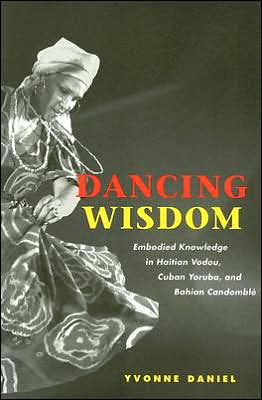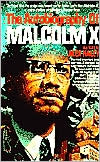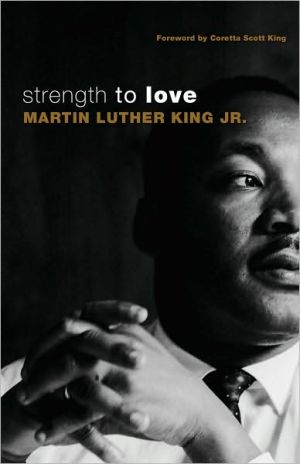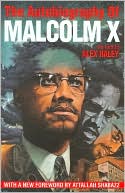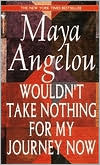Dancing Wisdom: Embodied Knowledge in Haitian Vodou, Cuban Yoruba, and Bahian Candomble
Search in google:
Dancing Wisdom\ Embodied Knowledge in Haitian Vodou, Cuban Yoruba, and Bahian Candomble \ \ By YVONNE DANIEL \ UNIVERSITY OF ILLINOIS PRESS\ Copyright © 2005 Yvonne Daniel\ All right reserved. \ ISBN: 0-252-07207-3 \ \ \ \ Chapter One\ Deciphering Diaspora Dances\ Their Origin Nations and Belief Systems\ I am fascinated by belief systems that rely heavily on dance behavior. While dance and music behaviors are not immediately associated with religious, sociopolitical, or politico-economic issues, they can reveal intriguing nonaesthetic information. In the following chapters I show how dance/music data make significant contributions to African Diaspora studies. In three African-derived religious systems of the Americas, dance performances are categorized by means of "spirit families," African "nations," or cosmic forces, called lwas in Haiti, and orichas and orixas in Cuba and Brazil, respectively. I refer to these spiritual entities as "divinities" so that I can speak of the religions jointly and avoid the use of the terms "gods and goddesses," which is misleading when we are trying to understand how worshipers understand. The divinities of these African American religions receive dance/music offerings within religious rites and come to dance with the believing community. For ritual community members, the dance/music performances suggest myths and retell cultural stories, but most important, they charter and encourage social behavior in present everyday lives.\ The word "religion" in contemporary English is derived from the Latin, religare, meaning "to bind back," "retie," "bond," or "fasten," and it is the human world that is fastened to the spiritual world in my three examples of African American ritual practice. Whether worshipers believe in sacred stone tablets, a virgin conception, enlightenment through silent meditation, or a higher consciousness through dance and drum rituals, religious beliefs tie most humans to a spiritual world. For the communities I study, Haitian Vodou and Cuban Yoruba in the Caribbean and Bahian Candomble in South America, it is most often the dance/music behavior within ritual behavior that continually reties the worshipping community to its spiritual affinity.\ Fundamentally, "religion" refers to the union of humans with either an omnipotent nonhuman or several suprahuman spiritual entities (de Santana Rodrigue 2001). In these three religions, the fastening of the human world to a spiritual world, and thereby the bonding of differing spheres of existence, occurs through or as a result of dance performance and/or music practices.\ There are similarities among the religious and dance/music systems that I study. For example, during my research I found that African ethnic groups such as the Fon and Yoruba meshed and intertwined their religious practices in the Americas. Even more intriguingly, I found that their origins in what are now the Republic of Benin and Nigeria are replete with mixing, exchange, and interaction over centuries, rather than the discrete national units about which we are often conditioned to think. Similarly, the many African ethnic groups of the Kongo-Angola region in Central Africa have lived as neighbors and shared cultures beyond what the geopolitical boundaries of any particular contemporary African nation might suggest.\ Such proximity and sharing have resulted in meshed belief systems. For example, one of the Yoruba spiritual entities, Elegba, is found among both Fon and Yoruba religions; also Ogou, another spiritual entity in Fon culture is called Ogun in Yoruba culture. Fon and Yoruba divining systems are shared as well, called Fa in Fon culture and Ifa in Yoruba culture. As Olabiyi Yai, a Yoruba linguist from Benin, has said, well before coming to the Americas, continental Africans were accustomed to having dual or multiple religious loyalties, in addition to dual or multiple cultural allegiances (Yai 2001:244-55). This has made the study of American contexts difficult when searching out origins and distinctions.\ My recent travel to the Yoruba and Fon areas of Benin has underscored for me an understanding of the consequences within a history of double or multiple religious loyalties. Many ethnic groups on the African continent have shared religious beliefs and practices as a result of trade, intermarriages, and conditions of war and enslavement. Distinct but similar belief systems have resulted, and often worshipers have professed double religious loyalties, such as in the story of the Yoruba and Fon wedding where the new bride brought her Yoruba divinities to add to the groom's Fon pantheon. Accordingly, worshipers could express affinity with either Fon or Yoruba religion or Fon or Yoruba national identity.\ I have repeatedly found this tendency toward multiple loyalties in the Americas. Despite what friends and associates might say at first, their behaviors have demonstrated religious mixtures. Today, the three religions that I discuss are complex, plural, and multidimensional amalgams that exhibit intra-African syncretism at their roots (Walker 1980:32-36; Daniel 1995:36; see also chapter 3 of this volume). For example, the Fon word vodun (spirits or gods) became the name of the Fon-derived Vodou religion in Haiti (Herskovits 1975 [1937]:140), but Haitian "spirits" are called lwas, mistes (mysteries), invisibles (invisibles), or ley mo (the dead [ancestors]), and not voduns. The term lwa comes from the Yoruba o loua, meaning "spiritual master." The usage of the terms vodun and lwas indicates the influence of two neighboring cultures on each other and their continued meshing within religious culture of the Americas.\ Another example of intra-African syncretism is found in the name for one of the Afro-Brazilian religions, Candomble, a Yoruba-based religious practice that is also called Nago/Ketu for the prominence of particular types of Yoruba peoples, those of the Nago and Ketu nations. The word "Candomble," however, comes from Bantu language origins in Central Africa, and not from the heavy West African religious core of the belief system. Thus, a West African religion came to be known by a Central African title.\ Both examples suggest intimate and profound exchange among African ethnic and regional groups upon their arrival in the Americas. These instances of intra-African syncretism continue a long tradition of similar exchange in ancient kingdoms and among varied regional groups on the continent. These also suggest different notions regarding nationhood.\ Again, Yai's important African data help to explain why numerical dominance, as opposed to cultural and ethnic allegiance, was not always the major criterion for the name that Africans in the Americas chose. He relates, for example, that Fon-related peoples who landed in Brazil chose the name of a small and politically weak group within their region of Africa, the Jeje nation. In so doing, Africans were articulating different values from the European model of "size and power yields name." Rather, Yai hypothesizes, the Jeje may have been the first Fon-related group to establish a Vodou religion or temple in the new environment; their language was mutually intelligible and they shared the same divinities (2001:251-52). Thus expressing nationhood in the Americas was dependent on several characteristics, religion being one. Careful consideration of intra-African syncretism implies that each of these religions contains beliefs and practices that were more often shared and not always original to any one ethnic group or religious community.\ My study analyzes the Fon-based case in Haiti and two Yoruba-based cases, one in Cuba and the other in Bahia, Brazil. Haitian Vodou, Cuban Yoruba, and Bahian Candomble utilize dance performance and music-making as primary vehicles for religious and spiritual transformation. They concur on divination systems in order to receive information from and communicate with a Supreme Being and his/her emissaries. The religions uphold life and death realms that constitute an ongoing vital universe and that involve funereal practices, spiritual manifestations, and animal sacrifices, which systematize relations among humans, divinities, and the Supreme Divinity.\ Through mounting numbers of worshipping practitioners, visual documentaries, and written analyses, more consideration of African American religions, as opposed to their previous "cult" descriptor, is emerging (e.g., Deren 1983, 1953; Dunham 1969; Courlander 1973; Laguerre 1980; Kramer 1981, 1985, 1988; Thompson 1983; Rolando 1988, 1999, 2001; Murphy 1988, 1994; Barnes 1989; Bolivar 1990; Brown 1991; Desmangles 1992; Brandon 1993; Canizares 1999; Matory 2001a, 2001b; Harding 2000; Vega 2000; de Santana Rodrigue 2001; Murphy and Sanford 2001).\ Now through analysis of ritual music and dance, even more knowledge about the significance of these religious traditions is available. In this study, I am transposing the often silent, nonverbal information that is embodied within lively and dynamic dance performances to make it at least partially explicit. In addition to dance and music analysis, I offer other explanations that come from cultural interpretation based on ethnographic field research within the three regions. My theme, therefore, is the shared and pivotal activity of three Diaspora religions-their dance/music behavior. I see the three religions as dance-dependent ritual structures with dance-initiating objectives that have captivated the interests of different populations around the world.\ Ultimately I am also concerned with how this behavior informs and challenges the notion of hierarchical types of knowledge. Embodied knowledge-that is, knowledge found within the body, within the dancing and drumming body-is rich and viable and should be referenced among other kinds of knowledge. In performance, and as my analyses show, Haitian, Cuban, and Bahian practitioners reveal and reference history, philosophy, religion, physiology, psychology, botany, and mathematics in addition to music and dance. These disciplines are among what the body articulates as it grows in spiritual practice over a lifetime.\ The "praise performance" that results from African belief systems makes these and other African-derived communities able to contend with contemporary society in the Americas. As practitioners perform divinity, they ultimately receive social medicine; in performing the music and dance and embodying the lwas, orichas, and orixas repeatedly, dancing worshipers grow in individual esteem and dignity. They become involved in ritual community service and display social decency. Dancing in repetitive ceremonial practice feeds the physical and social body.\ Embodied knowledge in African Diaspora communities has been revered and developed; it can reveal what the body knows, what it is capable of, and, recalling Foucault, what-what it does-does. Through resilient and exciting ritual performance, dance and music embody memory and perseverance and, in the end, inspire and support survival.\ Three African American Dance Rituals\ A Haitian Vodou Ritual, 1974\ It wasn't going to be my first trip to Haiti, but it would be my first trip alone in Haiti. I had received an unexpected gift from my recently deceased father, a small amount of money, and amid my sad and joyful tears, I immediately decided to risk it all. I would go to that intriguing island of Haiti. I knew that I was running away from intense stress and that I needed a break; I also realized that the monetary gift could afford me the opportunity to do further research on the Haitian Vodou dances that I had witnessed earlier.\ Prior to receiving the check late in the day, I had had only ten dollars to my name, with no balance in my checking account, and it was the Christmas season. I had fallen asleep with quiet tears the night before, totally frustrated and fatigued, wondering how I could manage a decent holiday season for my four sons and finish both choreographing my dance concert and writing my master's thesis in the next three months. My rationale then was that if I went to Haiti, my sons could continue to celebrate with their father, who had taken them on an extended camping and skiing trip in a huge luxurious trailer. They would not have to face my harsh realities and mounting depression, and I could concentrate for one month on my thesis work. I wrote a letter of explanation to them all, my ex and the boys, as to the length and focus of my travel. I hoped that they would understand.\ A week later, I was settled in a pension in Port-au-Prince with an elderly lady from Haiti's governing elite as hostess. My room was modest and comfortable with a firm double bed, beautiful white lace curtains, and a small, private bath, all within a converted "gingerbread house," a large home in the French planter architectural style with a lovely tropical garden surrounding the entire structure. My seven-dollars-a-day accommodations included two meals with other boarders. Each day I spotted my silver napkin holder with an engraved #12-my room number-at the same table with the English speakers. I tried to change places, at least after coffee, to meet and get to know other travelers, but it was obvious that I was breaking the rules of the house.\ Madame found this slightly irritating, but she was also a bit fascinated. For her, I was a young, seemingly intelligent and educated North American woman who was unusually interested in Haitian peasants and their dancing. Even though she had known Katherine Dunham decades earlier and was currently acquainted with several international dance students of Lavinia Williams Yarborough, she still marveled at our fascination with peasant dance culture. Madame Lavinia was well known in Port-au-Prince and, like Dunham, was an American who had made her home in Haiti for more than forty years. She had been in the original Katherine Dunham Dance Company and while teaching dance in Haiti became an investigator of Haitian dance culture. Everyone knew Mesdames Lavinia and Katherine, as the customs and immigration officers told me when I arrived at Port-au-Prince.\ I spent my mornings walking Haiti's steep dirt roads to Madame Lavinia's dance studio and taking classes-technique, folklore, and private instruction in the dances of Vodou. (Madame Dunham was not in Haiti that December.) I studied yanvalu, mayi, zepol, zarenyen, Nago, Petwo, Ibo, Congo, juba, Affranchi, and banda, learning each dance's nuance but also sensing the style of a genuine Haitian collective as compared with U.S. Afro-American versions of Haitian style. I had been studying Haitian dance in the States, where the stylization seemed rather theatrical; at least that is what I surmised after I witnessed and experienced the native island style on my first visit.\ Continues... \ \ \ \ Excerpted from Dancing Wisdom by YVONNE DANIEL Copyright © 2005 by Yvonne Daniel. Excerpted by permission.\ All rights reserved. No part of this excerpt may be reproduced or reprinted without permission in writing from the publisher.\ Excerpts are provided by Dial-A-Book Inc. solely for the personal use of visitors to this web site. \ \
1Deciphering diaspora dances : their origin nations and belief systems12Body knowledge at the crossroads513Days of remembrance944Dances of memory1045Praise dance and liturgical orders1486Informal learning with Haitian Lwas1637Informal learning with Bahian Orixas1888Formal learning with Cuban Orichas2059The dancing body and embodied wisdom246
